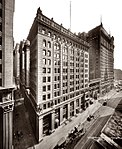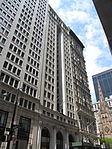The King's College (New York City)
1938 establishments in New Jersey1994 disestablishments in New York (state)1999 establishments in New York CityBriarcliff Manor, New YorkConservative organizations in the United States ... and 11 more
Educational institutions disestablished in 1994Educational institutions established in 1938Educational institutions established in 1999Evangelicalism in New York (state)Financial District, ManhattanLiberal arts colleges in New York (state)Nondenominational Christian universities and colleges in the United StatesThe King's College (New York City)USCAA member institutionsUniversities and colleges in ManhattanUse mdy dates from June 2014
The King's College (TKC or simply King's) is a private non-denominational Christian liberal arts college in New York City. The predecessor institution was founded in 1938 in Belmar, New Jersey, by Percy Crawford. The King's College draws more than 500 students from 37 states and 15 countries.
Excerpt from the Wikipedia article The King's College (New York City) (License: CC BY-SA 3.0, Authors).The King's College (New York City)
Broadway, New York Manhattan
Geographical coordinates (GPS) Address Nearby Places Show on map
Geographical coordinates (GPS)
| Latitude | Longitude |
|---|---|
| N 40.706666666667 ° | E -74.012222222222 ° |
Address
52 Broadway
Broadway 52
10004 New York, Manhattan
New York, United States
Open on Google Maps









